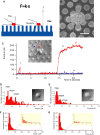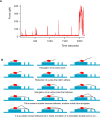Cooperative retraction of bundled type IV pili enables nanonewton force generation
- PMID: 18416602
- PMCID: PMC2292754
- DOI: 10.1371/journal.pbio.0060087
Cooperative retraction of bundled type IV pili enables nanonewton force generation
Abstract
The causative agent of gonorrhea, Neisseria gonorrhoeae, bears retractable filamentous appendages called type IV pili (Tfp). Tfp are used by many pathogenic and nonpathogenic bacteria to carry out a number of vital functions, including DNA uptake, twitching motility (crawling over surfaces), and attachment to host cells. In N. gonorrhoeae, Tfp binding to epithelial cells and the mechanical forces associated with this binding stimulate signaling cascades and gene expression that enhance infection. Retraction of a single Tfp filament generates forces of 50-100 piconewtons, but nothing is known, thus far, on the retraction force ability of multiple Tfp filaments, even though each bacterium expresses multiple Tfp and multiple bacteria interact during infection. We designed a micropillar assay system to measure Tfp retraction forces. This system consists of an array of force sensors made of elastic pillars that allow quantification of retraction forces from adherent N. gonorrhoeae bacteria. Electron microscopy and fluorescence microscopy were used in combination with this novel assay to assess the structures of Tfp. We show that Tfp can form bundles, which contain up to 8-10 Tfp filaments, that act as coordinated retractable units with forces up to 10 times greater than single filament retraction forces. Furthermore, single filament retraction forces are transient, whereas bundled filaments produce retraction forces that can be sustained. Alterations of noncovalent protein-protein interactions between Tfp can inhibit both bundle formation and high-amplitude retraction forces. Retraction forces build over time through the recruitment and bundling of multiple Tfp that pull cooperatively to generate forces in the nanonewton range. We propose that Tfp retraction can be synchronized through bundling, that Tfp bundle retraction can generate forces in the nanonewton range in vivo, and that such high forces could affect infection.
Conflict of interest statement
Figures




References
-
- Mattick JS, Whitchurch CB, Alm RA. The molecular genetics of type-4 fimbriae in Pseudomonas aeruginosa - a review. Gene. 1996;179:147–155. - PubMed
-
- Parge HE, Forest KT, Hickey MJ, Christensen DA, Getzoff ED, et al. Structure of the fibre-forming protein pilin at 2.6 A resolution. Nature. 1995;378:32–38. - PubMed
-
- Craig L, Volkmann N, Arvai AS, Pique ME, Yeager M, et al. Type IV pilus structure by cryo-electron microscopy and crystallography: implications for pilus assembly and functions. Mol Cell. 2006;23:651–662. - PubMed
-
- Burrows LL. Weapons of mass retraction. Mol Microbiol. 2005;57:878–888. - PubMed
-
- Merz AJ, So M. Interactions of pathogenic Neisseriae with epithelial cell membranes. Annu Rev Cell Dev Biol. 2000;16:423–457. - PubMed
Publication types
MeSH terms
Grants and funding
LinkOut - more resources
Full Text Sources

